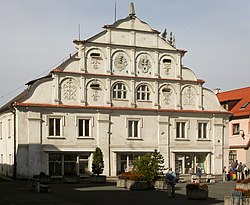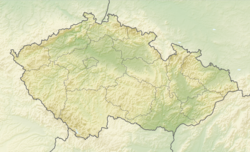Nýrsko (Czech pronunciation: [ˈniːrsko]; German: Neuern) is a town in Klatovy District in the Plzeň Region of the Czech Republic. It has about 5,100 inhabitants.
Nýrsko | |
|---|---|
 Municipal library on the town square | |
| Coordinates: 49°17′38″N 13°8′37″E / 49.29389°N 13.14361°E | |
| Country | |
| Region | Plzeň |
| District | Klatovy |
| First mentioned | 1327 |
| Government | |
| • Mayor | Miloslav Rubáš |
| Area | |
• Total | 31.53 km2 (12.17 sq mi) |
| Elevation | 452 m (1,483 ft) |
| Population (2024-01-01)[1] | |
• Total | 5,113 |
| • Density | 160/km2 (420/sq mi) |
| Time zone | UTC+1 (CET) |
| • Summer (DST) | UTC+2 (CEST) |
| Postal code | 340 22 |
| Website | www |
Administrative division
editNýrsko consists of seven municipal parts (in brackets population according to the 2021 census):[2]
- Nýrsko (3,985)
- Blata (15)
- Bystřice nad Úhlavou (374)
- Hodousice (107)
- Stará Lhota (49)
- Starý Láz (39)
- Zelená Lhota (184)
Zelená Lhota forms an exclave of the municipal territory.
Geography
editNýrsko is located about 15 kilometres (9 mi) southwest of Klatovy and 52 km (32 mi) south of Plzeň. Most of the municipal territory lies in the Bohemian Forest Foothills, but the southern part and the exclave lie in the Bohemian Forest. The highest point is a contour line on the slopes of the mountain Malý Prenet at 860 m (2,820 ft) above sea level. The Úhlava River flows through the town.
A small part of the Nýrsko Reservoir is located in the municipal territory. It was built in 1964–1969 and has a 36 m (118 ft) high stone dam. It serves as a source of drinking water for the region.[3]
History
editThe first written mention of Nýrsko is from 1327. The settlement was probably founded in the 12th century. It was situated on the trade route to Bavaria near the ford across the Úhlava. A custom house was located here.[4]
The lower part of the town called Dolní Nýrsko ("Lower Nýrsko") was a member of the Royal Chamber, and the upper part, Horní Nýrsko ("Upper Nýrsko"), was a market village under the ownership of the Pajrek Castle. In 1558 Horní Nýrsko joined Dolní Nýrsko and both became property of the municipality of Bystřice nad Úhlavou. The town developed and grew quickly at that time, and it obtained many rights and privileges from Emperor Rudolf II in 1593.[4]
The development continued in the 19th century when the town was industrialized. There were factories for matches and for linen, a tannery, a steam saw, two mills and a glass grinder. The turning point was primarily the start of production of optical products in 1895.[4]
Demographics
edit
|
|
| ||||||||||||||||||||||||||||||||||||||||||||||||||||||
| Source: Censuses[5][6] | ||||||||||||||||||||||||||||||||||||||||||||||||||||||||
Economy
editThe town is known for Okula Nýrsko, which was a major manufacturer of spectacle optics and mechanics. The local production started already in 1895, when the company was moved from Vienna. Nowadays, the company is still an important regional employer, but the production specializes mainly in plastics.[7]
Transport
editNýrsko is located on the railway line Prague–Plzeň–Železná Ruda and thus has a direct connection to the capital.[8]
Sights
editThe main landmark of the town is the Church of Saint Thomas the Apostle. It was first mentioned in 1352 and it is the oldest building in Nýrsko.[9] The Gothic church was extended in the second half of the 14th century, then early Baroque modification were made in the 17th century and further Baroque modifications in the 18th century.[10]
In Bystřice nad Úhlavou is the Bystřice nad Úhlavou Castle. A fortress in the area existed in 1339 at the latest. In 1444, it was rebuilt in the Gothic style and extended into a castle. Renaissance modifications were made at the turn of the 16th and 17th centuries. The building acquired its current appearance during the reconstruction by its owner Count Hohenzollern-Sigmaringen in 1848–1853, mostly in the pseudo-Romanesque and pseudo-Gothic styles. Because of the unusual combination of the aforementioned styles, the castle is not artistically valuable.[11]
Pajrek Castle is a castle ruin located on a hill, south of the town. The castle was founded at the beginning of the 14th century. From the mid-16th century it was permanently abandoned. The preserved remains of the palace walls and the tower are freely accessible.[12]
Notable people
edit- Jan Hošek (born 1989), footballer
References
edit- ^ "Population of Municipalities – 1 January 2024". Czech Statistical Office. 2024-05-17.
- ^ "Public Census 2021 – basic data". Public Database (in Czech). Czech Statistical Office. 2022.
- ^ "Vodní nádrž Nýrsko" (in Czech). CzechTourism. Retrieved 2022-12-13.
- ^ a b c "Historie Nýrska – stručná" (in Czech). Město Nýrsko. Retrieved 2022-12-13.
- ^ "Historický lexikon obcí České republiky 1869–2011" (in Czech). Czech Statistical Office. 2015-12-21.
- ^ "Population Census 2021: Population by sex". Public Database. Czech Statistical Office. 2021-03-27.
- ^ "Historie" (in Czech). OKULA Nýrsko. Retrieved 2021-06-11.
- ^ "Detail stanice Nýrsko" (in Czech). České dráhy. Retrieved 2023-07-05.
- ^ "Farní kostel sv. Tomáše apoštola" (in Czech). Město Nýrsko. Retrieved 2022-12-13.
- ^ "Farní kostel sv. Tomáše" (in Czech). National Heritage Institute. Retrieved 2022-12-13.
- ^ "Historie" (in Czech). Bystřice nad Úhlavou Castle. Retrieved 2022-12-13.
- ^ "Zřícenina hradu Pajrek u Nýrska" (in Czech). CzechTourism. Retrieved 2022-12-13.

